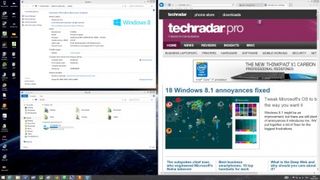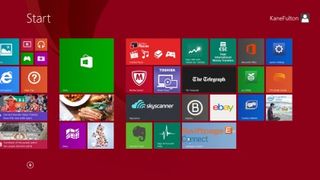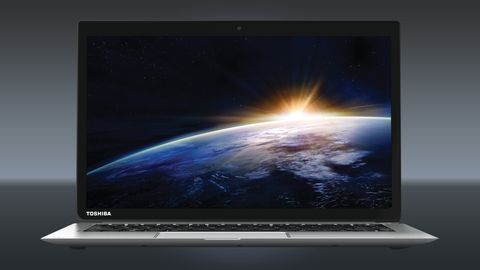Why you can trust TechRadar
Like other Ultrabooks with high resolutions, the Kira struggles with Windows 8.1's poor scaling abilities, making text and UI elements difficult to read in certain apps. Some apps combat this with more success than others.
The desktop version of Evernote, for example, doesn't attempt to adjust to the high resolution. You'll need to squint to pick out the names of Notes and Notebooks, and it's likely that you'll have to increase the font size of your Notes to read them comfortably.
Internet Explorer, on the other hand, sets itself to a 200% zoom level by default, which makes web pages appear comically large in comparison with everything else (I found that 125% made for comfortable reading).

Aside from playing around with individual apps' settings, the only other option is to change to a lower resolution, such as 1920 x 1080, which defeats the object of having a high-PPI display.
On the other hand, if small and unpredictable text and UI elements don't bother you, or if you mainly use Windows 8.1 apps (which always look great and are perfectly readable as they can scale to high resolutions, unlike desktop apps), you'll find that the large amounts of screen real-estate afforded by Kira comes in as a benefit rather than a negative.

The Kira comes with a fair bit of pre-installed software including a number of Sage apps (also trial versions), McAfee LiveSafe, Skyscanner, eBay and Swiftpage E-Connect.
Performance
Benchmarks
- Cinebench 11.5: OpenGL: 20.14 fps; C PU: 2.77pts
- 3DMark: Ice Storm: 15,086; C loud Gate: 4,622; F ire Strike: 625
- PC Mark 8 H ome battery life: 11 hours and 15 minutes
Our test model came with Windows 8.1, an Intel Core i7-4500 CPU clocked at 1.80GHz, 8GB of RAM and a 220SSD. The Kira's graphics are powered by an integrated HD 4400 chip, which handled 3DMark 8's lesser-demanding benchmarks with ease but began to struggle with increasingly complex renders.
It's fine for playing games running Valve's Steam engine around the 40-50 fps mark (if you lower the resolution to 1920x1080). However, as is expected from an integrated GPU, you won't experience those frame rates in newer games such as Battlefield 4 or Titanfall even if you drastically lowering the resolution.
Any tasks we undertook in desktop mode were nippy and responsive - from opening desktop programs to snapping multiple Windows apps side-by-side. Because of its speedy SSD, the Kira only took around 10 seconds to boot from cold.
Battery life saw a boost from the old model thanks to the inclusion of a Haswell (versus the 2013 model's Ivy Bridge) CPU variant, which allowed the device to clock in at just over 11 hours using PCMark 8 Home's battery life test, which continually opens and closes programs and loops video until the battery is depleted.

The Kira's port selection is good for an Ultrabook, offering a full-size HDMI output and two USB 3.0 ports on the left-hand side. On the right-hand side is an SD card slot, a 3.5mm stereo headset jack and one more USB 3.0 port. Connectivity options include 802.11ac Wi-Fi and Bluetooth 4.0.
Current page: Software, performance and battery life
Prev Page Introduction and design Next Page Hands on gallery

